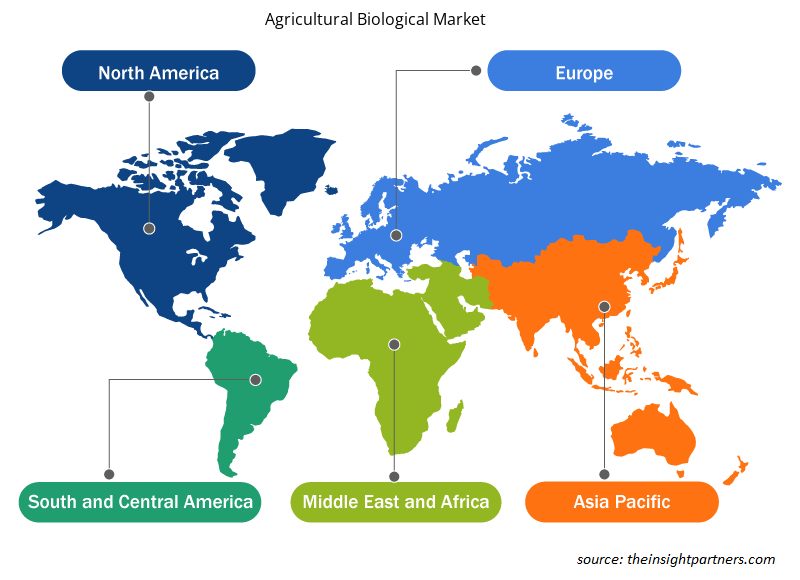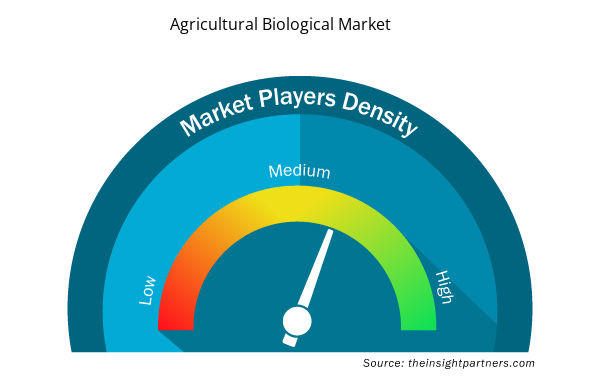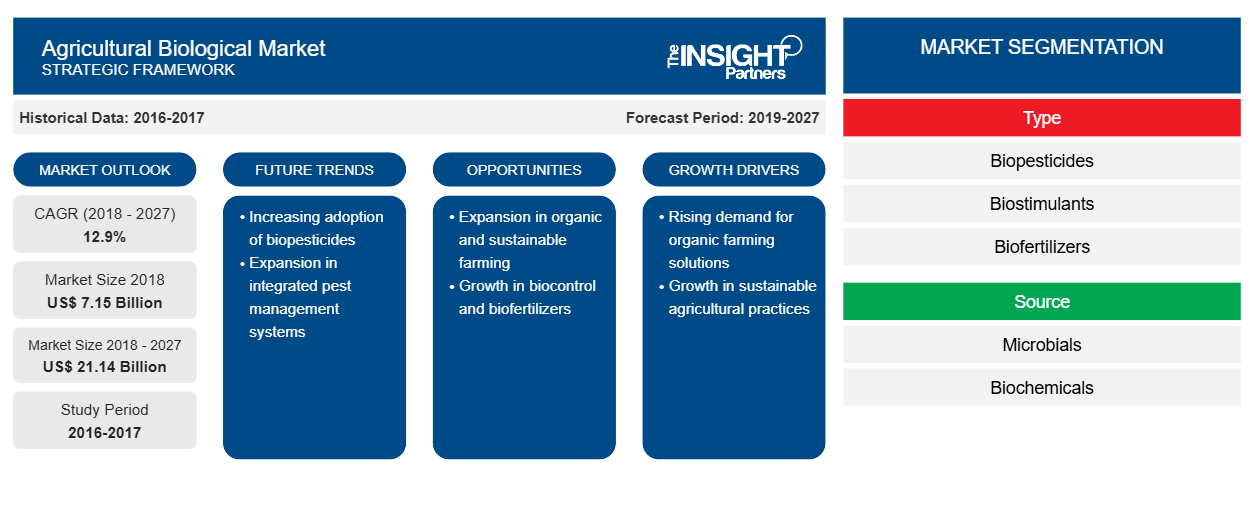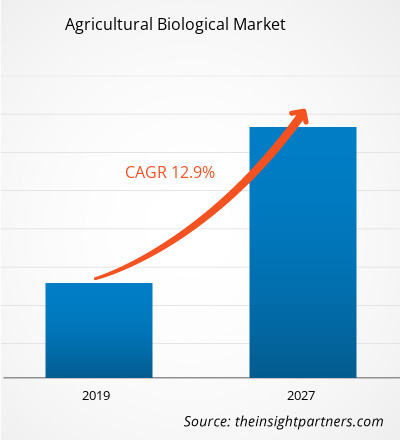[研究报告] 2018 年农业生物市场规模为 71.488 亿美元,预计在 2019 年至 2027 年的预测期内复合年增长率为12.9%,到 2027 年将达到 211.41 亿美元。
北美地区在全球农业生物市场中占有最大的市场份额。该地区农业生物市场的增长主要归因于消费者对有机食品的偏好转变,以及对研发活动的投资增加、政府对促进可持续实践的有利举措以及健康意识的提高是推动北美地区市场的主要因素。
市场洞察
天然产品比合成产品的采用率增加,导致了农业生物市场的增长
农业生物制品正越来越多地被用作合成或化学植物保护产品(如化学农药、杀菌剂或杀虫剂)的替代品。生物农药、生物刺激素和生物肥料等农业生物产品是一种天然产品,可促进土壤健康发展、植物病害控制、营养吸收增强、植物生长促进等。由于农业生物制品成本低、对环境影响小、对害虫产生抗药性的风险低,因此其需求量正在超过其他合成产品。
亚太地区健康食品需求上升将为全球农业生物市场创造增长机会
中国、印度、日本和韩国等发达国家对健康农作物食品的认识和需求不断增长,促使制造商生产农业生物产品。此外,由于生活方式的改变、中产阶级人口的增加、可支配收入的增长以及对健康产品的认识的提高,亚太地区的发展中国家在农业生物产品方面表现出巨大的潜力和增长前景。
定制此报告以满足您的需求
您可以免费定制任何报告,包括本报告的部分内容、国家级分析、Excel 数据包,以及为初创企业和大学提供优惠和折扣
- 获取此报告的关键市场趋势。这个免费样品将包括数据分析,从市场趋势到估计和预测。
应用模式洞察
根据应用模式,全球农业生物市场细分为叶面喷洒、土壤处理和种子处理。种子处理部分引领了全球农业生物市场。种子在杀虫剂、杀菌剂等的帮助下进行处理,以保护它们免受种子传播的病原生物的侵害。种子还受到太阳能照射或浸泡在经过调节的水中。它提供了各种优势,例如提高发芽率、控制土壤中的昆虫、预防植物疾病、早期生长和建立以及防止幼苗枯萎和种子腐烂。种子可以用各种程序类型进行处理,例如种子拌种、种子制粒和种子包衣。
来源洞察
全球农业生物市场根据来源可分为微生物、生物化学品和其他。微生物部分在全球农业生物市场中占最大份额。微生物是小型细菌和真菌生物,可分为真菌、细菌、病毒、原生动物等。它改善土壤的养分吸收,提供昆虫控制以预防疾病,并提高产量。它有助于吸收氮、钾、磷和硫等必需营养素,并因解决基本农业问题(如植物健康控制、作物生产力和土壤健康维护)以及环境问题(如土壤和水中无机和有机污染物的生物修复)而闻名。
并购、新产品开发等被视为全球农业生物市场最常采用的策略。以下列出了全球农业生物市场的一些最新发展:
- 2018 年:巴斯夫欧洲公司完成对拜耳股份公司的收购,以加强其种子平台并补充最近扩大的农业解决方案组合。
- 2018年:Koppert Biological Systems最近宣布在加州草莓市场推出其新的NatuGro系统。
- 2018 年:Marrone Bio Innovations, Inc. 推出了 TerraConnect,这是一个新的全球生物土壤应用和种子处理平台,为种植者提供高性能产品以及改良和保护作物的广泛有价值的工具。
农业生物制品
农业生物市场区域洞察
Insight Partners 的分析师已详细解释了预测期内影响农业生物市场的区域趋势和因素。本节还讨论了北美、欧洲、亚太地区、中东和非洲以及南美和中美洲的农业生物市场细分和地理位置。

- 获取农业生物市场区域具体数据
农业生物市场报告范围
| 报告属性 | 细节 |
|---|---|
| 2018 年市场规模 | 71.5亿美元 |
| 2027 年市场规模 | 211.4亿美元 |
| 全球复合年增长率(2018 - 2027) | 12.9% |
| 史料 | 2016-2017 |
| 预测期 | 2019-2027 |
| 涵盖的领域 | 按类型
|
| 覆盖地区和国家 | 北美
|
| 市场领导者和主要公司简介 |
|
农业生物市场参与者密度:了解其对业务动态的影响
农业生物市场正在快速增长,这得益于终端用户需求的不断增长,而这些需求又源于消费者偏好的不断变化、技术进步以及对产品优势的认识不断提高等因素。随着需求的增加,企业正在扩大其产品范围,进行创新以满足消费者的需求,并利用新兴趋势,从而进一步推动市场增长。
市场参与者密度是指在特定市场或行业内运营的企业或公司的分布情况。它表明在给定市场空间中,相对于其规模或总市场价值,有多少竞争对手(市场参与者)存在。
在农业生物市场运营的主要公司有:
- 巴斯夫
- 拜欧奇姆公司
- Certis 美国有限责任公司
- 陶氏杜邦公司
- 伊萨格罗公司
免责声明:上面列出的公司没有按照任何特定顺序排列。

- 了解农业生物市场顶级关键参与者概况
全球农业生物市场细分
按类型
• 生物农药• 生物刺激素• 生物肥料
按来源
• 微生物• 生物化学品• 其他
按应用方式
• 叶面喷洒• 土壤处理• 种子处理
按应用
• 谷物和谷类• 油籽和豆类• 水果和蔬菜• 其他
按地理位置
北美
- 我们
- 加拿大
- 墨西哥
欧洲
- 德国
- 法国
- 意大利
- 英国
- 俄罗斯
- 欧洲其他地区
亚太地区
- 澳大利亚
- 中国
- 印度
- 日本
- 韩国
- 亚太其他地区
中东和非洲 (MEA)
- 南非
- 沙特阿拉伯
- 阿联酋
- MEA 其他地区
南美洲
- 巴西
- 阿根廷
- 南美洲其他地区 (SAM)
公司简介
- 巴斯夫
- 拜欧奇姆公司
- Certis 美国有限责任公司
- 陶氏杜邦公司
- 伊萨格罗公司
- 科珀特生物系统公司
- Marrone 生物创新公司
- 先正达
- 联合磷化
- Valent BioSciences LLC
- 历史分析(2 年)、基准年、预测(7 年)及复合年增长率
- PEST 和 SWOT 分析
- 市场规模价值/数量 - 全球、区域、国家
- 行业和竞争格局
- Excel 数据集



Report Coverage
Revenue forecast, Company Analysis, Industry landscape, Growth factors, and Trends

Segment Covered
This text is related
to segments covered.

Regional Scope
North America, Europe, Asia Pacific, Middle East & Africa, South & Central America

Country Scope
This text is related
to country scope.
Trends and growth analysis reports related to Chemicals and Materials : READ MORE..
The List of Companies - Agricultural Biological Market
- BASF SE
- Biolchim S.p.A.
- Certis U.S.A. LLC
- DowDuPont Inc.
- Isagro S.p.A
- Koppert Biological Systems
- Marrone Bio Innovations, Inc.
- Syngenta
- UPL
- Valent BioSciences LLC
The Insight Partners performs research in 4 major stages: Data Collection & Secondary Research, Primary Research, Data Analysis and Data Triangulation & Final Review.
- Data Collection and Secondary Research:
As a market research and consulting firm operating from a decade, we have published and advised several client across the globe. First step for any study will start with an assessment of currently available data and insights from existing reports. Further, historical and current market information is collected from Investor Presentations, Annual Reports, SEC Filings, etc., and other information related to company’s performance and market positioning are gathered from Paid Databases (Factiva, Hoovers, and Reuters) and various other publications available in public domain.
Several associations trade associates, technical forums, institutes, societies and organization are accessed to gain technical as well as market related insights through their publications such as research papers, blogs and press releases related to the studies are referred to get cues about the market. Further, white papers, journals, magazines, and other news articles published in last 3 years are scrutinized and analyzed to understand the current market trends.
- Primary Research:
The primarily interview analysis comprise of data obtained from industry participants interview and answers to survey questions gathered by in-house primary team.
For primary research, interviews are conducted with industry experts/CEOs/Marketing Managers/VPs/Subject Matter Experts from both demand and supply side to get a 360-degree view of the market. The primary team conducts several interviews based on the complexity of the markets to understand the various market trends and dynamics which makes research more credible and precise.
A typical research interview fulfils the following functions:
- Provides first-hand information on the market size, market trends, growth trends, competitive landscape, and outlook
- Validates and strengthens in-house secondary research findings
- Develops the analysis team’s expertise and market understanding
Primary research involves email interactions and telephone interviews for each market, category, segment, and sub-segment across geographies. The participants who typically take part in such a process include, but are not limited to:
- Industry participants: VPs, business development managers, market intelligence managers and national sales managers
- Outside experts: Valuation experts, research analysts and key opinion leaders specializing in the electronics and semiconductor industry.
Below is the breakup of our primary respondents by company, designation, and region:

Once we receive the confirmation from primary research sources or primary respondents, we finalize the base year market estimation and forecast the data as per the macroeconomic and microeconomic factors assessed during data collection.
- Data Analysis:
Once data is validated through both secondary as well as primary respondents, we finalize the market estimations by hypothesis formulation and factor analysis at regional and country level.
- Macro-Economic Factor Analysis:
We analyse macroeconomic indicators such the gross domestic product (GDP), increase in the demand for goods and services across industries, technological advancement, regional economic growth, governmental policies, the influence of COVID-19, PEST analysis, and other aspects. This analysis aids in setting benchmarks for various nations/regions and approximating market splits. Additionally, the general trend of the aforementioned components aid in determining the market's development possibilities.
- Country Level Data:
Various factors that are especially aligned to the country are taken into account to determine the market size for a certain area and country, including the presence of vendors, such as headquarters and offices, the country's GDP, demand patterns, and industry growth. To comprehend the market dynamics for the nation, a number of growth variables, inhibitors, application areas, and current market trends are researched. The aforementioned elements aid in determining the country's overall market's growth potential.
- Company Profile:
The “Table of Contents” is formulated by listing and analyzing more than 25 - 30 companies operating in the market ecosystem across geographies. However, we profile only 10 companies as a standard practice in our syndicate reports. These 10 companies comprise leading, emerging, and regional players. Nonetheless, our analysis is not restricted to the 10 listed companies, we also analyze other companies present in the market to develop a holistic view and understand the prevailing trends. The “Company Profiles” section in the report covers key facts, business description, products & services, financial information, SWOT analysis, and key developments. The financial information presented is extracted from the annual reports and official documents of the publicly listed companies. Upon collecting the information for the sections of respective companies, we verify them via various primary sources and then compile the data in respective company profiles. The company level information helps us in deriving the base number as well as in forecasting the market size.
- Developing Base Number:
Aggregation of sales statistics (2020-2022) and macro-economic factor, and other secondary and primary research insights are utilized to arrive at base number and related market shares for 2022. The data gaps are identified in this step and relevant market data is analyzed, collected from paid primary interviews or databases. On finalizing the base year market size, forecasts are developed on the basis of macro-economic, industry and market growth factors and company level analysis.
- Data Triangulation and Final Review:
The market findings and base year market size calculations are validated from supply as well as demand side. Demand side validations are based on macro-economic factor analysis and benchmarks for respective regions and countries. In case of supply side validations, revenues of major companies are estimated (in case not available) based on industry benchmark, approximate number of employees, product portfolio, and primary interviews revenues are gathered. Further revenue from target product/service segment is assessed to avoid overshooting of market statistics. In case of heavy deviations between supply and demand side values, all thes steps are repeated to achieve synchronization.
We follow an iterative model, wherein we share our research findings with Subject Matter Experts (SME’s) and Key Opinion Leaders (KOLs) until consensus view of the market is not formulated – this model negates any drastic deviation in the opinions of experts. Only validated and universally acceptable research findings are quoted in our reports.
We have important check points that we use to validate our research findings – which we call – data triangulation, where we validate the information, we generate from secondary sources with primary interviews and then we re-validate with our internal data bases and Subject matter experts. This comprehensive model enables us to deliver high quality, reliable data in shortest possible time.


 获取此报告的免费样本
获取此报告的免费样本